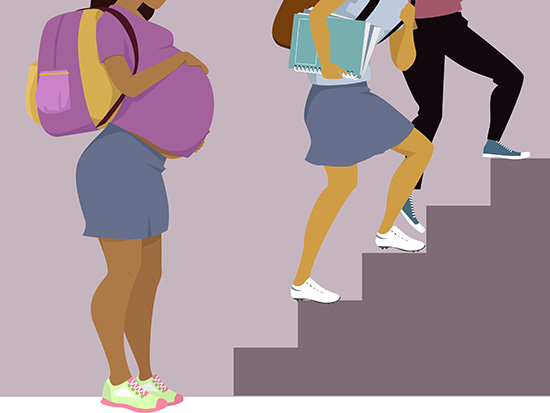 Educational differences between teen mothers and other women were most pronounced among millennial women of higher socioeconomic status because they had the largest potential to be educated, given their backgrounds.Different social contexts can transform the meaning and implications of life experiences. For example, a life event like teen childbirth can have vastly different impacts depending on the era and societal norms. In the post-World War II baby boom, teen births were relatively common. The 1960s, however, was the beginning of a period that marked increasing economic returns from education for women and changing norms about the timing of motherhood.
Educational differences between teen mothers and other women were most pronounced among millennial women of higher socioeconomic status because they had the largest potential to be educated, given their backgrounds.Different social contexts can transform the meaning and implications of life experiences. For example, a life event like teen childbirth can have vastly different impacts depending on the era and societal norms. In the post-World War II baby boom, teen births were relatively common. The 1960s, however, was the beginning of a period that marked increasing economic returns from education for women and changing norms about the timing of motherhood.
A University of Alabama at Birmingham study published in the American Journal of Sociology found that teen births were more disruptive for the education of more recent cohorts of women than for older cohorts. These exacerbated effects within recent generations were because of the increasing educational costs for women in the latter half of the 20th century, especially for millennial women born between 1980 and 1984.
The study, led by Joseph D. Wolfe, Ph.D., and Mieke Beth Thomeer, Ph.D., both associate professors in the UAB College of Arts and Sciences Department of Sociology, along with Shawn Bauldry, Ph.D., at Purdue, compared older millennial women to silent generation and baby boomer women to show the changing meaning of teen births for educational attainment.
“We sought to understand how the educational costs of teen births evolved for women,” Wolfe said. “We chose these specific cohorts to represent women who lived before, during and after significant cultural shifts in women’s education in the United States. We also accounted for different opportunities, constraints and attitudes regarding women’s age at first birth and educational attainment.”
According to the study, educational differences between teen mothers and other women were most pronounced among millennial women of higher socioeconomic status because they had the largest potential to be educated, given their backgrounds. The women with later births in this generation were the highest-achieving in terms of education, indicating that having a teen birth represented a growing opportunity cost for women.
“Traditional framings of teen births see them as a ‘social problem’ to be avoided because they disrupt education and career advancement, but our research shows that the meaning of teen births for educational attainment depends both on historical and socioeconomic contexts,” Thomeer said.
Therefore, Thomeer suggests that, rather than focusing only on avoiding teen pregnancy to increase educational success, change is required in structural factors that have facilitated certain groups of women being more able to go to college and to avoid pregnancy in adolescence.
The researchers recommend future studies to incorporate information about public policies at multiple levels to better understand changes over time because trends in childbearing and their costs are highly influenced by public policies.
“We hope that the results of this study will lead to policies that focus on improving access to higher education, rather than just on contraception and sex education, to reduce teen births by making education a more attractive option,” Thomeer said.